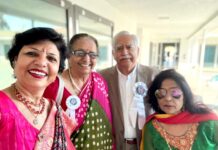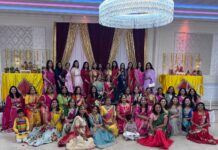 The Battle of Saragarhi was fought during the Tirah Campaign on September 12, 1897 between twenty-one Sikhs of the 4th Battalion (then 36th Sikhs) of the Sikh Regiment of British India, defending an army post, and 15 to 20 thousand Afghan and Orakzai tribesmen in a last stand. The battle occurred in the North-West Frontier Province, now a part of Pakistan and located in the wild Pakistan -Afghanistan border.
The Battle of Saragarhi was fought during the Tirah Campaign on September 12, 1897 between twenty-one Sikhs of the 4th Battalion (then 36th Sikhs) of the Sikh Regiment of British India, defending an army post, and 15 to 20 thousand Afghan and Orakzai tribesmen in a last stand. The battle occurred in the North-West Frontier Province, now a part of Pakistan and located in the wild Pakistan -Afghanistan border.
The contingent of the twenty-one Sikhs was led by Havildar Ishar Singh. They all chose to fight to the death. Sikh military personnel and Sikh civilians commemorate the battle every year on 12 September, as Saragarhi Day.
Saragarhi is a small village in the border district of Kohat, situated on the Samana Range, Pakistan.
In August 1897, five companies of the 36th Sikhs under Lt. Col. John Haughton were sent to the North West Frontier Providence, stationed at Samana Hills, Kurag, Sangar, Sahtop Dhar and Saragarhi.
Pashtuns attacked British personnel from time to time. Thus a series of forts, originally constructed by Maharaja Ranjit Singh, were consolidated. Two of the forts were Fort Lockhart, and Fort Gulistan situated a few miles apart. Due to the forts not being visible to each other, Saragarhi was created midway, as a communication post. The Saragarhi post, situated on a rocky ridge, consisted of a small block house with loop-holed ramparts and a signaling tower.
A general uprising by the Afghans began there in 1897, and from 27 August-11 September, many efforts by Pashtuns to capture the Forts were thwarted by 36th Sikh regiment.
On September 12, 1897, 15 to 20,000 Pashtuns attacked the signaling post at Saragarhi, so that communication would be lost between the two forts.
Details of the Battle of Saraghari are considered fairly accurate, due to Signalman Gurmukh Singh signaling events to Fort Lockhart as they occurred.
Around 9.00am, around 15 to 20,000 Afghans reached the signaling post at Saragarhi.
Signalman Gurmukh Singh signals to Col. Haughton in Fort Lockhart, that they are under attack. Colonel Haughton states he cannot send help to Saragarhi.
The soldiers decide to fight to the last to prevent the enemy reaching the forts.
Bhagwan Singh is the first killed and Lal Singh is seriously wounded.
Soldiers Lal Singh and Jiwa Singh reportedly carry the dead body of Bhagwan Singh back to the inner layer of the post.
The battle rages fiercely and despite ferocious resistance by the Sikhs, the enemy break a portion of the wall of the picket.
Colonel Haughton signals that he has estimated between 15,000 to 20,000 Pashtuns attacking Saraghari.
The leaders of the Afghan forces reportedly make promises to the soldiers to entice them to surrender.
Reportedly two determined attempts are made to rush the open gate, but are unsuccessful.
In an act of outstanding bravery, Ishar Singh orders his men to fall back into the inner layer, whilst he remains to fight. However, this is breached and all but one of the defending soldiers are killed, along with many of the Pashtuns.
Signalman Gurmukh Singh, who communicated the battle with Col. Haughton, was the last Sikh defender. He communicates his last message to Haughton… “This is my last signal. Picking up gun to fight.”
He is said to have killed over 20 Afghans. As he lay dying he was said to have yelled the Sikh war cry “Jo Bole So Nihal, Sat Sri Akal” repeatedly. This information came from Afghan sources.
The Afghans later claimed about 180 killed and many more wounded during the battle against the 21 Sikh soldiers, but some 800 to 900 bodies are said to have been seen around the ruined post when the relief party arrived.
All the 21 Sikhs were posthumously awarded the Indian Order of Merit, the highest gallantry award of that time, which an Indian soldier could receive by the hands of the British crown.
The names of the 21 recipients of the gallantry award are:
Havildar Ishar Singh (regimental number 165); Naik Lal Singh (332)
Lance Naik Chanda Singh (546); Sepoy Sundar Singh (1321); Sepoy Ram Singh (287); Sepoy Uttar Singh (492); Sepoy Sahib Singh (182)
Sepoy Hira Singh (359); Sepoy Daya Singh (687); Sepoy Jivan Singh (760); Sepoy Bhola Singh (791); Sepoy Narayan Singh (834); Sepoy Gurmukh Singh (814); Sepoy Jivan Singh (871); Sepoy Gurmukh Singh (1733); Sepoy Ram Singh (163); Sepoy Bhagwan Singh (1257); Sepoy Bhagwan Singh (1265); Sepoy Buta Singh (1556); Sepoy Jivan Singh (1651); Sepoy Nand Singh (1221).
The battle has been compared to the Battle of Thermopylae, where a small Greek force faced a large Persian army of Xerxes (480 BC). It is important to note that during the Battle of Saragarhi, the British did not manage to get a relief unit there until after the 21 had fought to their deaths. At Thermopylae too, the 300 Spartans also stayed after their lines had been breached, to fight to their deaths.
Saragarhi, in comparison is a greater feat of bravery considering the odds – one Sikh to over a thousand tribals.
Unfortunately, human memory is short and today nothing is known about their descendants, an outright disgrace. Tracing their descendants should not be difficult as113 years is but a flash of time where history is concerned. Surely there must be a home in the state of Punjab in India where a Sikh family proudly displays a picture of their Great-Great Grandfather Havaldar Ishar Singh.
However India Post was able to reach Dr Rajinder Singh Ranu, Prof. Plant Pathology at Colorado State University.
Dr Rajinder Singh is the grandson of Sepoy Nand Singh.
According to him Hav Ishar Singh’s grandson is apparently a Nihang Singh living in the Patiala area. Apart from that little or nothing is known about other descendants.
The Sikhs have not forgotten. Commemorative gurudwaras (Sikh Temples) were constructed in the cities of Amritsar, Ferozpur and Saragarhi where services are held every year on Sept 12.
Every year the Sikh Regiment of the Indian Army organizes a memorial service to remember these fallen heroes. Known as Saragarhi Day, the Indian Army pays solemn tribute to the twenty one lonely heroes who made the supreme sacrifice on that wind swept outpost 115 years ago.
The pictures are original taken back then after the relief forces arrived. The memorial still exists.
JS Bedi






